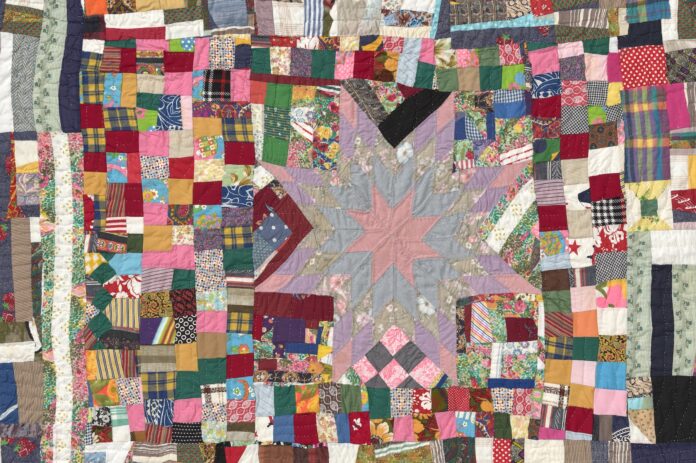At the end of the press preview, I was curious. We gathered journalists had just spent the last half-hour-or-so observing the decades-old—in some case, over a century-old—quilts made of every conceivable material, from cotton and silk to old newspaper, of Routed West: 20th Century African American Quilts in California (runs through November 30 at Berkeley Art Museum and Pacific Film Archive). Some of them are still strong enough to be pulled in multiple directions, others so delicate that they have to rest on special platforms. I couldn’t help but ask curator Elain Yau how each quilt’s creator(s) would care for them so as to ensure their longevity.
Yau didn’t know the answer, though she assumed some of them were washed with the regular laundry—but she did enlighten us as to the maintenance process at BAMPFA. A professional team carefully cleans the quilts with an intricate CO² process before delivering them to the archive in “acid-free boxes.” From its creation to current exhibition, each quilt’s perseverance is as inspiring as its delicacy is frightening.
Yet, ingenuity is likely to be the strongest takeaway from Routed West. Most of the quilts were created for practical use. During the Second Great Migration in the post-WWII-era, they could make the difference between sleeping or freezing for the Black families who moved out of the South towards the West. As mentioned, they made use of whatever materials were on hand to make them: rags; blue jeans; fine linens; and even old clothes. Whether by intention or pure happenstance, each piece tells a story.

That certainly wasn’t lost on BAMPFA executive director Julie Rodrigues Widholm, who told us the exhibit is one of the most ambitious in the archive’s history (which is saying something, considering they let one artist permanently place their work in the walls): 100 quilts from over 90 different creators spanning 100+ years, and most of them from owners and creators right here in the Bay Area.
Many of the pieces come from the collection of Eli Leon, whose “eye for quilts”, as Yau put it, “could occasionally be controversial”. A white man becoming the self-appointed gatekeeper for Black history is rife with cultural landmines. One is grateful for his tireless research, even while cringing at his insistence on injecting himself into the narrative—something Yau and BAMPFA wisely avoid.
The exhibit is divided into four sections, starting with “Southern Roots.” A simplified map on the wall tracks the Southern states where many of the artists originated, with a second map beside it showing where they landed on the Coast. This display is also where we’re introduced to the touchable display fragments accompanying several of the quilts, which allow patrons to get a literal hands-on experience for the texture and strength (or delicacy) in a way that mere sight alone can’t translate.
Per the name, the “Southern Roots” quilts all have a very “picnic blanket” look and feel to them, with each seeming to have been made during long hours in the sun. Even here, pieces like Emma Hall’s Untitled (Double Wedding Ring) (1940) and Willia Etta Graham’s Untitled (Cross and Circles) (1950) make one take a step back when the description cards explain that they were put together by hand.
Since most of the creators lacked any professional art skills, it should come as no surprise that many pieces don’t have proper titles. Nevertheless, their significance wasn’t lost on their family members, which is why the second section of the exhibit is called “Carried and Kept”. Its focus is the use of the quilts as family heirlooms.
This is where you’ll find works like Lucinda Ballenger’s Untitled (Six-Point Star Variation), which is dated 1900. It’s presented on a slanted board, as it’s too fragile to be hung traditionally. Its colors have all but faded and there are noticeable frays when one gets close. The piece was hand-stitched by a Black woman born 10 years before the start of the Civil War.
This leads directly into “Tending Generations”, which focuses on the passing-down of quilt-making in and of itself. Noticeable in this area are a collection of patchwork dolls made by Oakland’s Angelia Tobias in the 1990s. We also find Arbie Williams’ untitled quilt made from overalls in 1993, and Gerstine Scott’s necktie quilt from 1989. The transition of the sections is done in such a way that one hardly notices the evolution of the designs from practical-if-creative early examples to more recent works, created out of pure artistic expression. The subtle evolution shows how this vision was likely present from the beginning.
Perhaps nowhere does the practical blend with the purely expressive than in the collected works of Isiadore Whitehead. Rather than a single piece, Whitehead’s collection is displayed in a corner of the archive that recreates her entire bedroom. Amongst family photos and wooden furniture, Whitehead’s quilts are used as curtains, chair cushion covers, and a large blanket for the bed itself. One wonders how the BAMPFA staff got the entire installation in, but it works as a visualization of how the quilts were made part of their creators’ (and heirs’) everyday lives. It’s hard to believe Whitehead’s “loud” patterns could simply fade into the background, but seeing the same thing over and over has that effect.

The exhibit concludes with “A Living Tradition”, a section full of pieces made as recently as last year. There are awards and citations from national quilt-making societies, and images of protests and Kamala Harris sewn into different fabrics.
After a century-plus of family-to-family practice, quilt-making has become a niche activity rather than necessity. That doesn’t make the result any less moving. True, works like Terri Green’s Black Girl Magic (2022) don’t have the instant awe of the pieces made when the art form was at its height. But a piece like Carolyn Pope-Chappell’s Maya’s Urban African Chic (2021) is the very sort of mosaic that could easily hang beside the older pieces with no one being the wiser.
While its older pieces can astound simply from their “lived-in” condition and the more recent works show the benefit of pure artistic impulse, the beauty of the Routed West collection is that there is less disparity than one might expect. What all the quilts have common is that they were made by Black woman (and a few credited Black men) as an act of survival. Whether survival from the elements or the mere hope that one could survive the day without being shot by cops, they all represent a longing for a normalcy that was—nay, is—routinely denied.
Very few of the creators are still living—Yau told of going through scores of genealogy records and public documents to get permission to put them on display. But whether their primary goal was art or warmth, they’ve built something to last.
ROUTED WEST: 20TH CENTURY AFRICAN-AMERICAN QUILTS IN CALIFORNIA runs through November 30. Berkeley Art Museum and Pacific Film Archive, Berkeley. Tickets and more info here.





